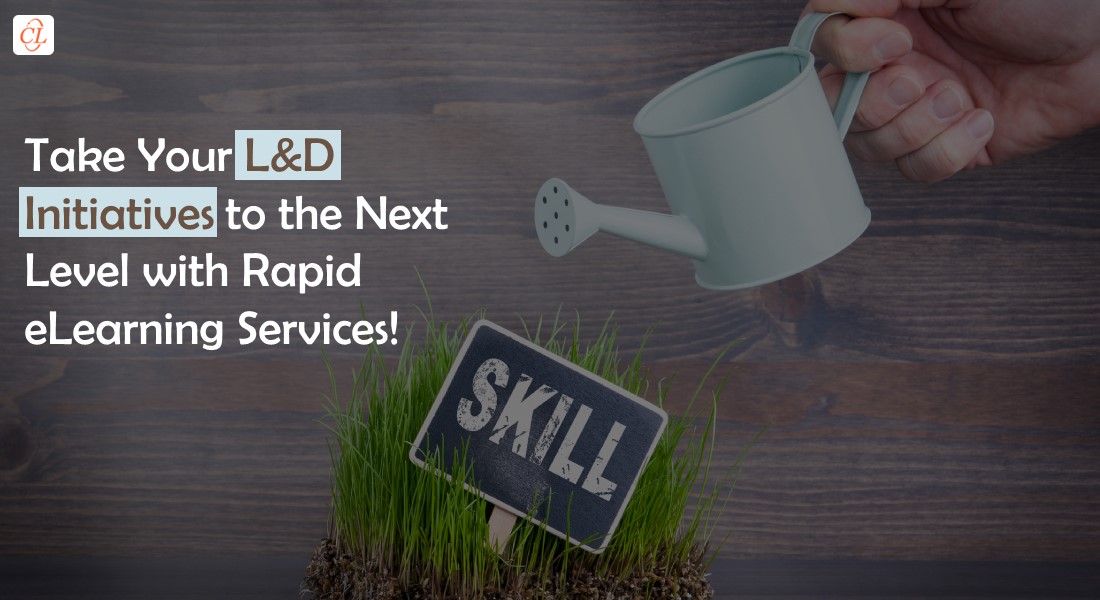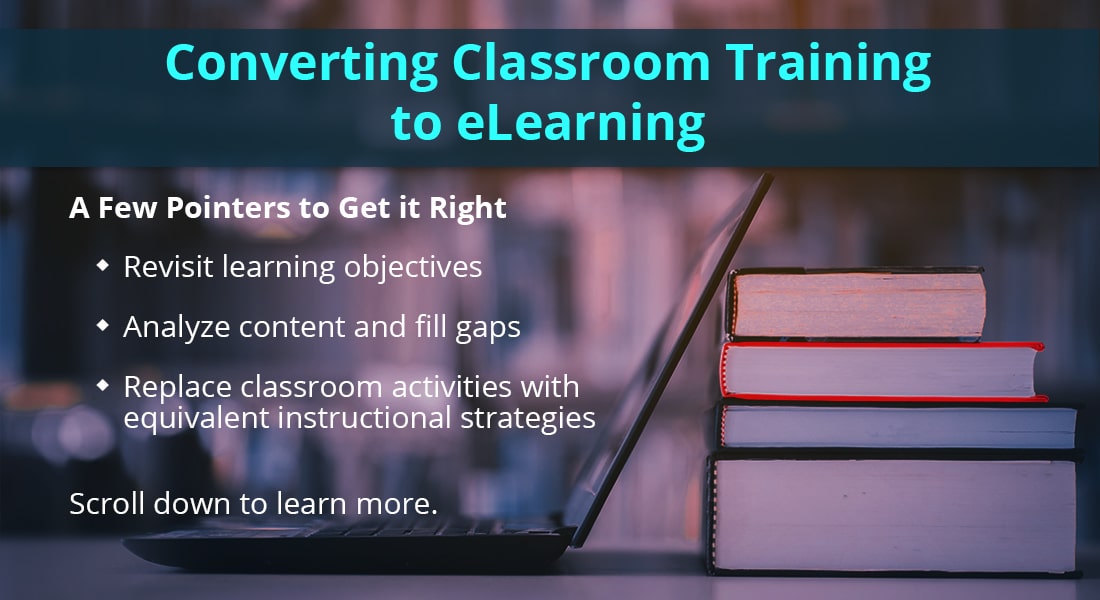Why Convert ILT Material to eLearning and What to Expect From it

If its many advantages and ever-growing popularity during recent years didn’t compel organizations to adopt eLearning, the COVID pandemic certainly has done so. The eLearning industry is on route to reaching a staggering $449 Billion by 2025, up from the estimated $250 Billion in 2020. The unmatched advantages eLearning offers over traditional Instructor-Led Training (ILT) are the main driving force behind this surge.
Training managers accustomed to traditional training methods will find it hard to ride this wave. True, classroom training still has its own place and definite advantages, but you can’t go against the oncoming sea change. For such professionals, converting classroom training content to e-learning will serve as an ideal option to go with the times, making use of the abundant classroom material they have with them.
Find out how ready your classroom training material is for eLearning.
Transitioning from classroom to eLearning involves a slew of steps, with a well-thought-out strategy guiding the entire process. It requires stakeholders at various levels of the organization to contribute to its success. Training Managers have a critical role to play here, as they’ll be required to offer guidance before, during, and after the conversion. It is, thus, imperative that they have sound knowledge of the concept, the processes involved, and the expected results.
ILT to eLearning Conversion Steps that Deliver the Best Results in the Shortest Time
- Adapting classroom learning objectives to the online environment
- Analyzing available content, and filling gaps wherever required
- Selecting a suitable instructional design strategy
- Adding assessments
So, What Exactly is ILT to eLearning Conversion?
In the simplest terms, ILT to eLearning conversion is the process of adapting existing classroom learning material to their virtual versions. This conversion happens in a series of steps designed to maximize the efficiency of the process while ensuring that no crucial aspect such as learning objectives, instructional design, relevant subject matter, etc., is left out of the final result.
If you are grappling with lack of qualified talent, acquiring such talent, scaling up, etc. for your conversion needs, then outsourcing can help tremendously. Competent eLearning vendors will use the latest techniques like rapid eLearning to get the job done quickly, using the best authoring tools and talent around.
Here’s What the Conversion Entails
The following four-step process has proven to deliver the best conversion results for your training requirements:
1. Adapting the Learning Objectives
Learning objectives are the north star of training. They guide the development of content throughout its lifecycle. When aligned with the organization’s overall business goals, they help instructional designers identify the content for the eLearning course that will help in achieving the said goals. For the learner, learning objectives provide clarity on what they will be able to do at the end of the course.
eLearning aims to deliver self-paced learning without the presence of an instructor. That is in sharp contrast to ILT, where the instructor could meander into related topics, adding a lot of extra information not present in books and documents. eLearning needs to be precise and crisp, focusing on vital need-to-know information as against nice-to-know information that can be provided as extra resources. Adapting the performance-based learning objectives sets the ball rolling on devising the instructional design strategy that best recreates the effectiveness of traditional classroom training.
2. Analyzing the Content and Filling Gaps
Content is king, whatever the training. The organization’s classroom material will be the primary source for eLearning conversion, supported by inputs from subject matter experts (SMEs). After finalizing the learning objectives, the instructional design team must decide on what content to retain and how best to adapt it for eLearning.
They should also verify if the content is up to date with the help of the SME to avoid inaccurate and insufficient information going into the course. It is, thus, vital for SMEs to thoroughly analyze the content before the conversion. IDs must also try to include the classroom trainers’ inputs from their experience and expertise that are shared during classroom sessions.
A meeting, or a few, involving the necessary stakeholders should help sort out ambiguities. A presentation could also come in handy. Outsourcing can streamline the entire process, eliminating content that is likely to contain irrelevant information.
3. Selecting a Suitable Instructional Design Strategy
The eLearning course needs to be engaging and informative enough to make up for the lack of an instructor. A robust instructional design strategy is needed to make that happen. The latest mapping strategies can recreate classroom interactivities in the course without compromising their effectiveness.
Here’s a list of how traditional interactivities can be mapped to their eLearning equivalents (Classroom – eLearning):
- Icebreakers – Attention Grabbers
- Demos – Videos
- Hands-on Practice Exercises – Simulations
- Role Plays – Scenarios
- Q & A Sessions – Formative Assessments
- Classroom Discussions – LMS Board Discussions
- Learning Activity Reviews – Reflection Activities
Visual design also has an important role to play here. The absence of the instructor can be compensated by the usage of animated avatars, for example. Eye-catching colors, engaging and attractive graphical user interfaces (GUIs), and the use of clear and relevant images wherever applicable will help the learner get the maximum out of the learning modules. A visual style blueprint should, therefore, not be kept on the backburner.
The same goes for audio also. An eLearning module with professional voiceover goes a long way in increasing engagement and retention. Also, learning effectiveness can be improved if learners are provided training in their native language, making eLearning translations a crucial aspect of the conversion process.
4. Incorporating Assessments
Classroom instructors can check learners’ knowledge, attention, and recall, or even start discussions in the classroom with periodic/random reviews and questions during the session. After the session also, random quizzes, weekly tests, question hours, etc. are conducted to assess learning.
All this is possible in eLearning also with online assessments. The LMS helps in location and device-agnostic testing, tracking of scores & completion rates, reporting, etc.
eLearning assessments may be:
Icebreakers: Ice breaker questions about the subject at hand can be posed at the start of the course. They help set the context for the course and can also be used to test recall. Importantly, they help grab learners’ attention.
Formative Assessments: These occur at the end of every learning objective or learning point within a course and are meant to reinforce learning, not assess the learner. They should always be accompanied by feedback, explaining why a particular response was right or wrong. They could be in the form of multiple-choice questions, fill-in-the-blanks, match the following, or more engaging ones like scenarios or gamification.
Summative Assessment: This is the final quiz at the end of the course and is similar to a final exam. Summative assessments are used to assess whether the learner has achieved the performance-based learning objectives that were set.
It’s a Wrap
Shifting to eLearning from the classroom changes more than the mode of training; it is a dimensional shift in outlook for everyone involved. If done well, self-paced eLearning can be as effective as classroom training, while also saving on time and cost and avoiding the logistical hassles of organizing regular classroom sessions.
To explore how you can make eLearning design and development a successful proposition even when you outsource it to an external vendor, download this comprehensive guide to eLearning outsourcing.





